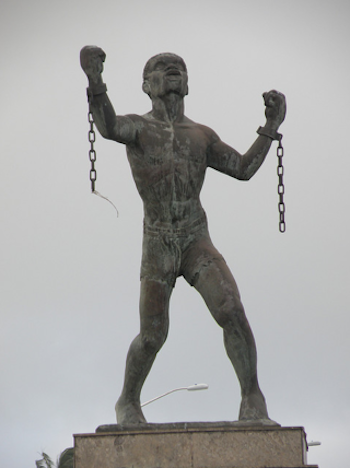
*Afro Barbadians are celebrated on November 30, 1519. Often called Black Barbadians, they are of entirely or primarily African descent.
Most of the enslaved Africans brought to Barbados were from the Bight of Biafra (62,000 Africans), the Gold Coast (59,000 Africans), and the Bight of Benin (45,000 Africans). Other African slaves came from Central Africa (29,000 slaves), Senegal Gambia (14,000 Africans), the Windward Coast (13,000 slaves), and Sierra Leone (9,000 slaves). Barbados' African tribes were primarily Igbo, Ibibio, and Efik; Africans from the Gold Coast were primarily Akan; Africans from the Bight of Benin were primarily Yoruba, Ewe, and Fon; and Africans from Central Africa were primarily Kongo.
When white English colonizers first arrived on the island in the 1620s, Barbados was mostly unpopulated. Its indigenous Taino and Amerindian people had fled or were captured by slave traders. As the colonists adopted sugar production as Barbados's central industry, the European colonists passed laws legitimizing slavery and established big plantations reliant on enslaved Africans. Rum and sugar were the focus of the industry In Barbados. As it developed into the leading commercial enterprise, Barbados was divided into large plantation estates, replacing the small early English settlers as the wealthy planters pushed out the poor.
The Irish were poor white slaves and planters who became the first police force and fishermen in Barbados. Some displaced farmers relocated to the English colonies in North America, mainly South Carolina. Black African slaves were imported in such numbers that in the last two decades of the 17th century, Blacks outnumbered whites by a margin of two to one, and, in the 18th century, there were three Blacks for every one planter. Sugar cane dominated Barbados's economic growth, and the island's cash crop was at the top of the sugar industry until 1720. Slaves were involved in various activities and multiple roles: raising livestock, fertilizing the soil, growing provisional crops, maintaining plantation infrastructure, caregiving, and various other tasks.
One notable soil-management technique was intercropping, planting subsistence crops between the rows of cash crops – which demanded of the slaves skilled and experienced observations of growing conditions for efficient land use. In the mid-1640s, the population of Barbados had over 18,000, many of whom were coerced or voluntary indentured servants, but the number of "Negro slaves" was around 8,000. By the mid-1650s, there was near parity with 20,000 Africans and 25,000 Europeans. By the mid-1670s, there were approximately 33,000 enslaved people and 21,500 Europeans (both indentured and free).

Due to the increased implementation of slave codes, which created differential treatment between Africans and European workers and the ruling planter class, the island became increasingly unattractive to poor whites. Slave codes were implemented in 1661, 1676, 1682, and 1688. In response to these codes, several unsuccessful slave rebellions were attempted or planned. Nevertheless, planters expanded their importation of African slaves to cultivate sugar cane. By 1660, Barbados generated more trade than all the other English colonies combined. This remained the case until it surpassed Jamaica in 1713.
Even so, in 1731, the estimated value of the colony of Barbados was as much as £5,500,000. Since the beginning of the eighteenth century, most Black Barbadians have been born on the island, facilitating the creation of a Barbadian identity for many years. Moreover, as occurred in the white population, the percentage was much higher for women than men, unlike in other Caribbean islands, where it was the opposite. This facilitated the reproduction of the Black population during the second half of the 18th century without relying on new imports of Africans to maintain the same output of slave labor. In addition, the birth rate was higher than the mortality rate. However, in the early 19th century, there continued to be imported African slaves in Barbados.
Increasingly after 1750, the plantations were owned by absentee landlords living in Great Britain and operated by hired managers. Between 1627 and 1807, approximately 387,000 enslaved Africans were sent to Barbados. Barbados (Bridgetown, in particular) re-exported many slaves to North America, other Caribbean islands, and the Captaincy General of Venezuela. Later, the Royal African Company established offices in Jamaica and Barbados. The Company preferred the origins of the slaves' work. Thus, the Company considered, as reported once, that certain slaves were worth more than other slaves from a specific region. Thus, slaves were re-exported from Jamaica to Mexico, while slaves were re-exported from Barbados to Venezuela.
The slave trade ceased in 1807, and slaves were emancipated in Barbados in 1834. Barbados gained independence from Britain in 1966. 92.4% of Barbados's population is Black, and 3.1% is multiracial, based on estimates in 2010. Afro Barbadian culture and music are mixtures of African and British music, with certain unique elements derived from Indigenous sources. Tension between African and British culture has long been a major element of Barbadian history and has included banning certain African-derived practices and Afro Barbadian parodies of British traditions. Barbadian cuisine consists of a blend of foods with African and British influences. Most Barbadians are Christian (whether practicing or otherwise). The Rastafari movement also has its community of adherents. Notable Afro Barbadians include Frank Collymore, Rihanna, Prince Hall, Richard B. Moore, William Shorey, Gwendolyn Knight, and others.